Physical Address
304 North Cardinal St.
Dorchester Center, MA 02124
9.1
9.2
9.3
9.4
9.5
Visit Expert Consult ( expertconsult.inkling.com ) for videos on topics discussed throughout the text.
As we do for most of our human functions, we take facial movements for granted. Quick, complete, and frequent blinks of the eyelids keep the cornea healthy. Narrowing of the eyelid fissures, or guarding, protects an irritated eye. Reflex closure of the lids is a spontaneous reaction to avoid trauma to the eye. However, problems of both overactivity and underactivity of the facial muscles are common. Conditions related to overactivity of the facial muscles include:
Orbicularis myokymia
Hemifacial spasm
Essential blepharospasm
Meige syndrome
Facial tics
Aberrant regeneration of the facial nerve
Problems of underactivity of the facial muscles are seen as well. A loss of facial expression is seen in patients with many of the myogenic ptoses that we have discussed and in patients with Parkinson disease. Facial nerve palsy can occur with a number of conditions and results in typical anatomic and functional abnormalities, including incomplete eye closure and corneal exposure, ectropion, and brow ptosis. You may see localized areas of facial weakness resulting from traumatic damage to facial nerve branches and muscles. We have already discussed ptosis syndromes associated with generalized muscle weakness, including myotonic dystrophy, chronic progressive external ophthalmoplegia (CPEO), and oculopharyngeal dystrophy. If you have not already become a student of facial expression, you surely will as your experience grows!
These are situations that an oculoplastic surgeon sees daily in practice. The conditions are easily differentiated on a clinical basis and rarely require any sophisticated testing to confirm your clinical impression. Each condition of overactivity or underactivity requires a different therapeutic approach.
In this chapter, we review the normal anatomy and function of the facial nerve and the muscles of facial expression. The pathologic conditions involving overactivity and underactivity of the facial muscles are discussed separately. In each section, we look at the important findings in the history and physical examination to help you make the correct diagnosis and formulate an appropriate treatment plan. Last, we explore the options for medical and surgical therapy for each disorder.
The facial nerve extends from its origin in the brainstem to the innervation of the facial muscles. There are two areas of particular interest to us. The first is the point at which the facial nerve leaves the brainstem in close proximity to the fifth and eighth nerves. The second location is distal to the appearance of the facial nerve trunk in the face anterior to the tragus of the ear. From this point, the facial nerve trunk divides into five branches ( Figure 9.1 ):
Cervical
Mandibular
Buccal
Orbital
Temporal
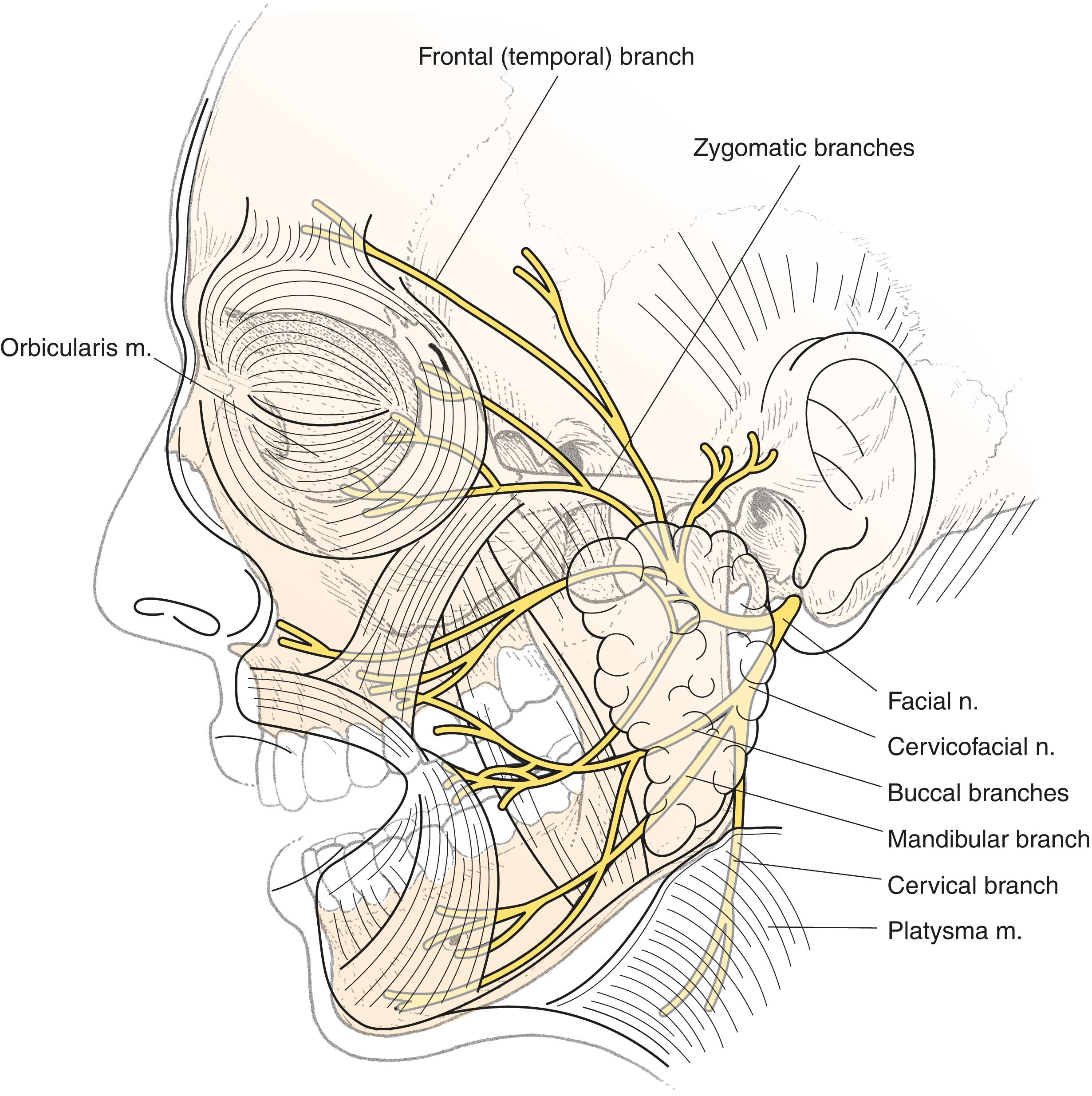
These branches innervate groups of the facial muscles selectively. Depending on the cause, facial nerve weakness may involve the entire nerve or individual branches. Bell palsy or any injury to the nerve proximal to the branching of the facial nerve involves the entire face. Accidental or surgical trauma to the face can result in injury localized to one or more branches. All nerves have the ability to regenerate. Unfortunately, regeneration of the facial nerve occurs in a nonanatomic manner known as aberrant regeneration of the facial nerve. You may see this in a patient after a cheek laceration heals. If you look carefully, you may see that the entire cheek moves as a whole or may move in synchrony with eyelid movement. Similarly, after facial nerve palsy, all branches of the facial nerve receive the same innervation. A signal to any branch of the facial nerve causes the entire face to move a bit. Pursing of the lips narrows the patient’s palpebral fissure ( Figure 9.2 ). Blinking causes the movement of the entire face, most noticeable at the corner of the mouth. You soon become aware of facial asymmetries in your patients. Remember, your examination begins when the patient enters the room. Your conversation as you get to know the patient often gives you clues to the type and cause of the patient’s problem. At some point, view the accompanying videos to this chapter to give you a better understanding of these movement abnormalities.
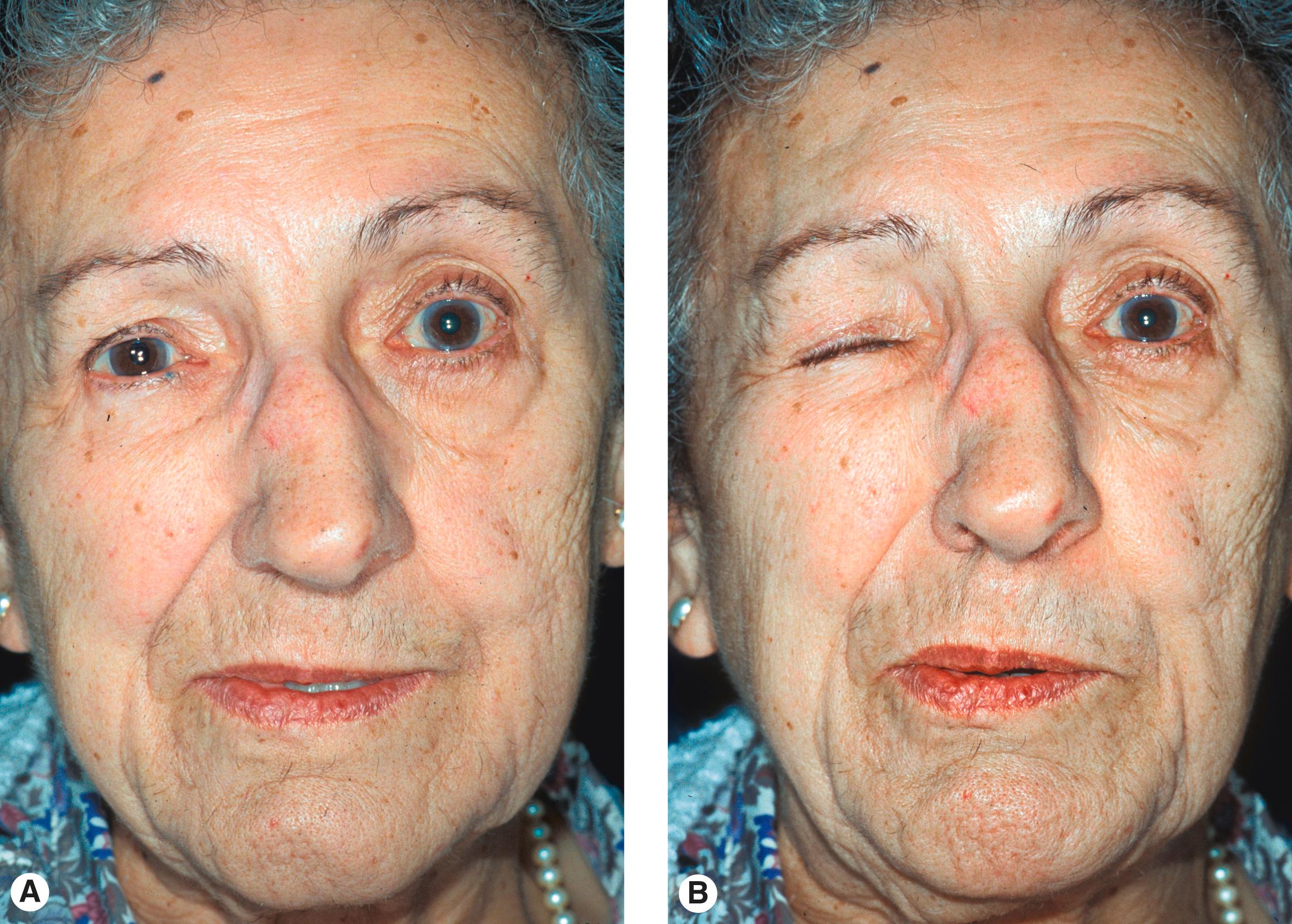
All the muscles of the face are innervated by branches of the seventh nerve. The orbicularis muscle is responsible for eyelid closure. The orbicularis is divided into three areas: The orbital orbicularis causes forceful squeezing of the eye, and the preseptal and pretarsal portions of the orbicularis are responsible for the quick blinks that lubricate the cornea. The orbicularis muscle receives innervation from several branches of the facial nerve such that localized trauma has to be fairly extensive to cause a significant paralysis of the orbicularis muscle. You can test for eyelid closure weakness by asking the patient to forcefully close the eyes. Normal forceful closure buries the eyelashes ( Figure 9.3 ). As you become an experienced observer, you recognize that some patients have a weak or incomplete blink. This is easiest to see in a patient with a unilateral facial palsy. This may be clinically insignificant, or it may reveal itself as inferior corneal exposure with fluorescein staining seen on slit lamp examination. In our discussion of levator function, we mentioned the speed of the upper eyelid excursion. This is a similar observation; a patient with orbicularis palsy has a slower-than-normal velocity of closure.
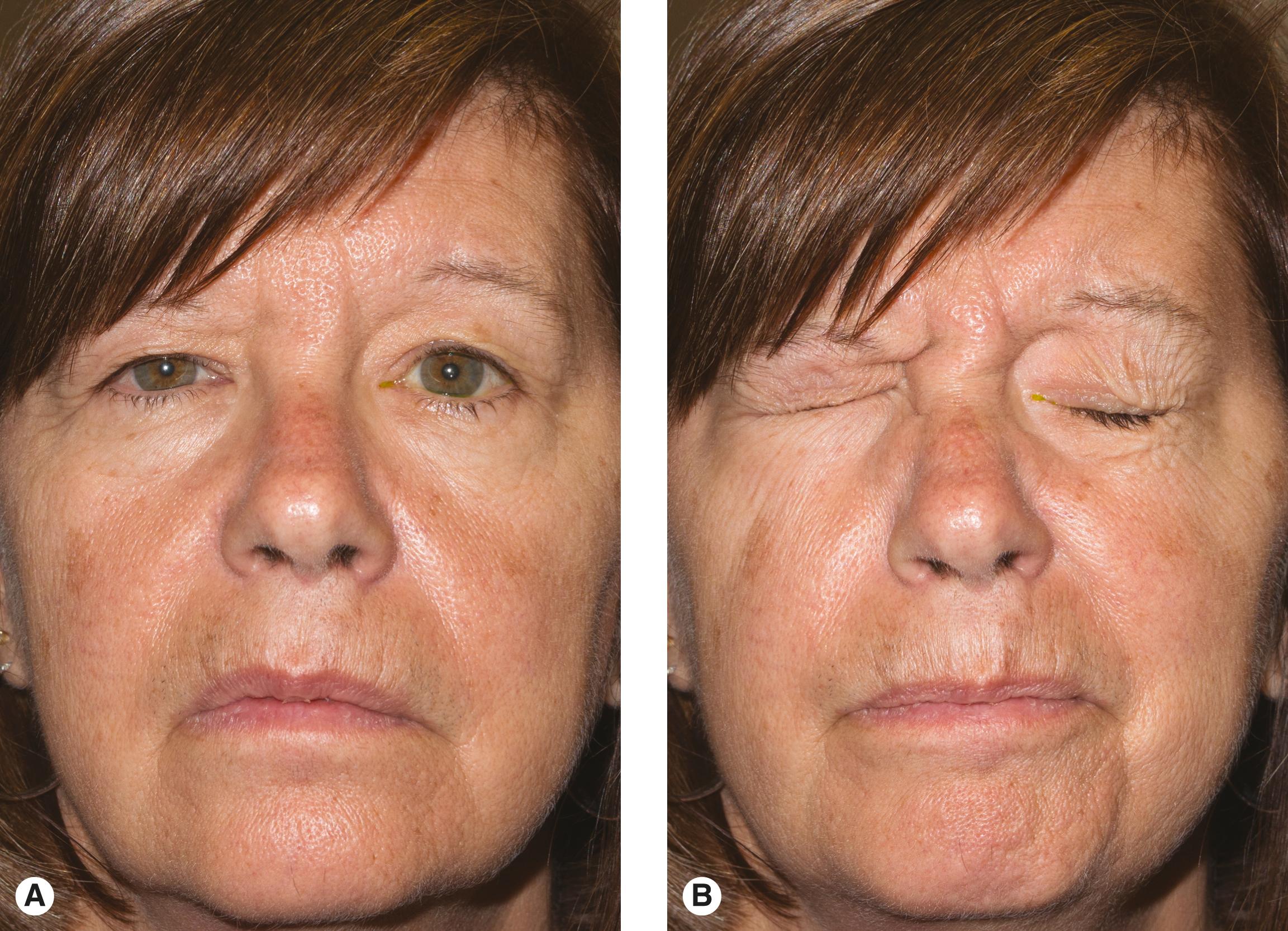
Both the corrugator and the procerus muscles are also innervated by the facial nerve ( Figure 9.4 ). These muscles are known, respectively, for the creation of the vertical (or slightly angled) wrinkles and the horizontal glabellar wrinkles. The corrugator muscle also plays a prominent role in the forceful eyelid closure of essential blepharospasm.
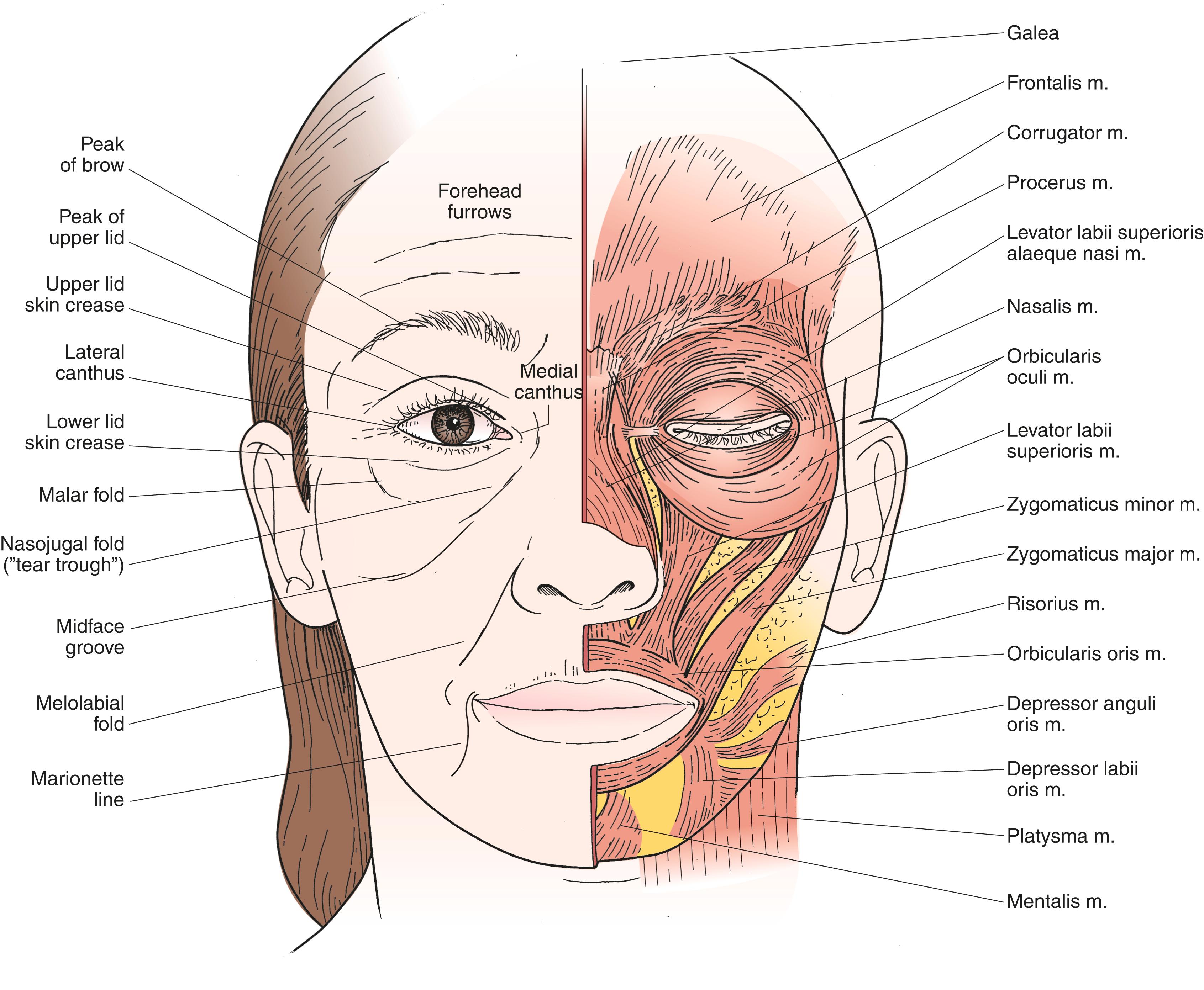
The frontalis muscle lifts the eyebrows and forehead. This muscle is innervated by a single branch of the facial nerve, the temporal branch. Injury to the temporal branch (also called the frontal branch) can cause a permanent brow ptosis.
Loss of function of the lower facial muscles results in a drooping of the midface and lip, as well. In patients with mild weakness, you see slight facial asymmetry and a shallowness of the nasal labial fold. This asymmetry can be brought out by asking the patient to make a broad smile.
Orbicularis myokymia is a common condition. It generally occurs in younger patients who note an involuntary twitching of the upper or lower eyelid. The abnormal movements are quick, lasting a second or less. The movements are easily noticed by the patient but require your close observation to see them. The movements result from spasm of individual bundles of muscle fibers. The muscle as a whole is not in spasm. Orbicularis myokymia is related to stress, fatigue, use of alcohol, or use of excessive caffeine. On rare occasions, the spasm becomes prolonged and botulinum toxin (Botox) injections can be used to relieve it; only a tiny amount is needed, such as 1 unit, in one or more areas.
Facial tics are voluntary movements of a group of facial muscles. In most situations, the patient is actually not aware that he or she is controlling the movements. The condition may be a unilateral movement of the eyelids and side of the face or may be simply a bilateral increase in blinking rate. Some tics may be more complex. There is often some secondary gain obtained with the tic, although that is difficult to identify. Tics occur most commonly in children but can also be seen in adults ( Figure 9.5 ). Probably you have already seen patients with tics. We discuss their diagnosis in more detail later.
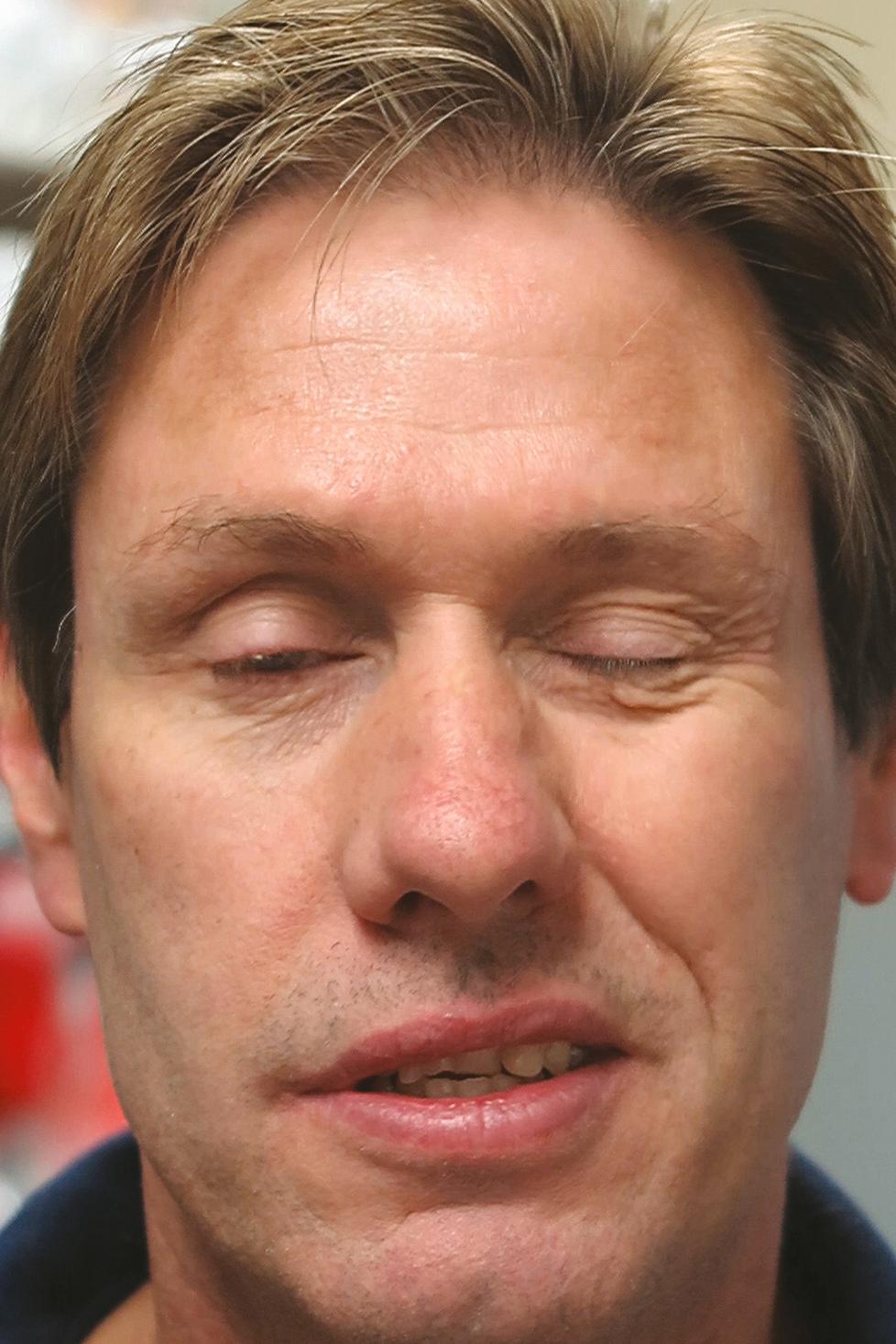
Hemifacial spasm is an involuntary movement of one side of the face ( Figure 9.6 ). The movement may be a quick apparent twitch or may be seen as a sustained spasm involving all the facial muscles on the side. The etiology of facial spasm is thought to be vascular compression of the facial nerve where the nerve leaves the brainstem. Frequently, the hemifacial spasm is accompanied by signs of mild facial weakness and aberrant regeneration (movement of the lower face causes movement of the upper face, and vice versa).
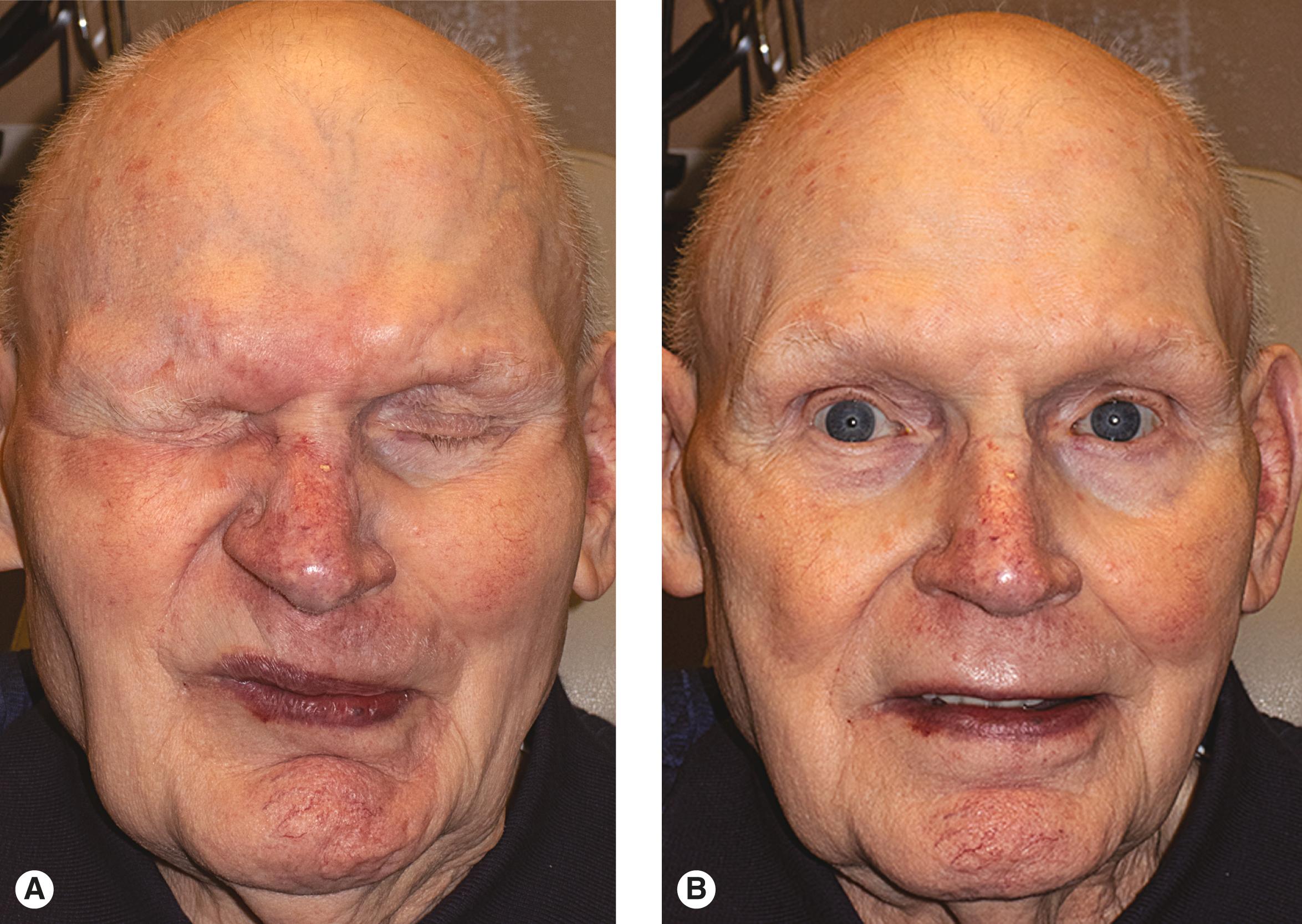
Essential blepharospasm presents as an uncontrolled blinking or spasm of both eyes ( Figure 9.7 ). Essential blepharospasm results from progressive degeneration of the central nervous system thought to occur in the basal ganglia. It is most commonly seen in elderly patients. Initially, the disorder may start as increased blinking, but it generally progresses to a more sustained spasm of both eyes with prominent orbital orbicularis and corrugator muscle activity. Botox injections make a tremendous improvement in the spasm for most patients.
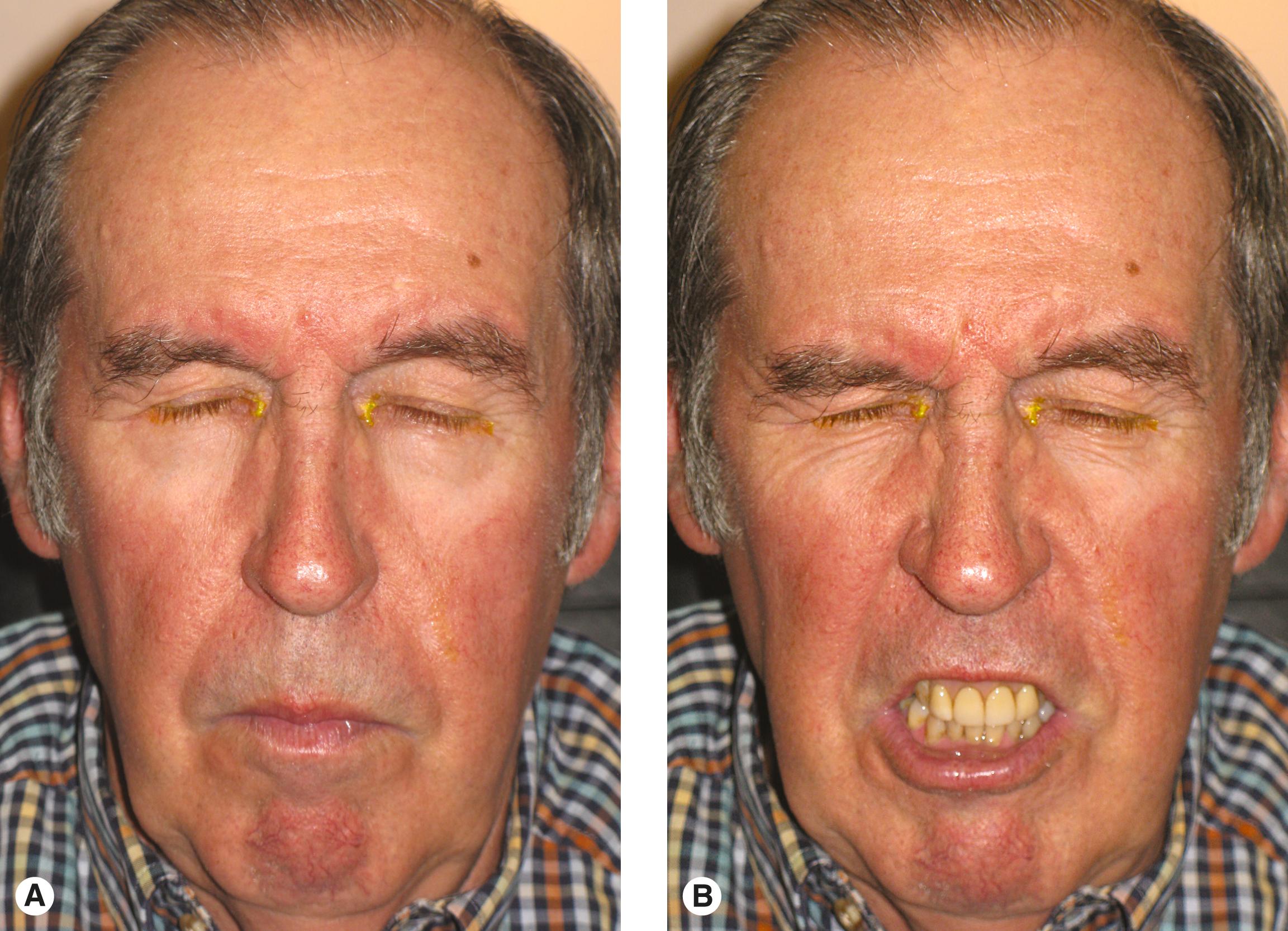
As the disorder progresses, patients lose the ability to open the eyes ( apraxia of eyelid opening ). The brain is sending uncontrolled impulses to close the eyes, including both orbicularis muscle contraction and levator muscle relaxation . In the early phases of the disorder, the spasm seems to predominate. Following the Botox injections, the spasm is diminished but the patient is left with eyes that have forgotten how to open. The patient no longer has a spasm that predominates. The patient just finds that it is more comfortable to keep the eyes closed because it is a struggle to open them.
Apraxia is difficult to treat. There is no known treatment to stimulate the levator muscle. The frontalis sling procedure can benefit some patients by increasing the efficiency of the frontalis muscle in opening the eyes. I have seen patients that improve significantly, but many patients show no benefit whatsoever. Some doctors inject a tiny amount of Botox into the pretarsal orbicularis (1 unit or so) as a supplemental treatment for apraxia. I have done this and cannot say whether it helps or not.
Abnormal movements of the lower face may be seen in association with essential blepharospasm, known as Meige syndrome ( Figure 9.8 ). Another, more descriptive, term for Meige syndrome is oral facial dystonia.
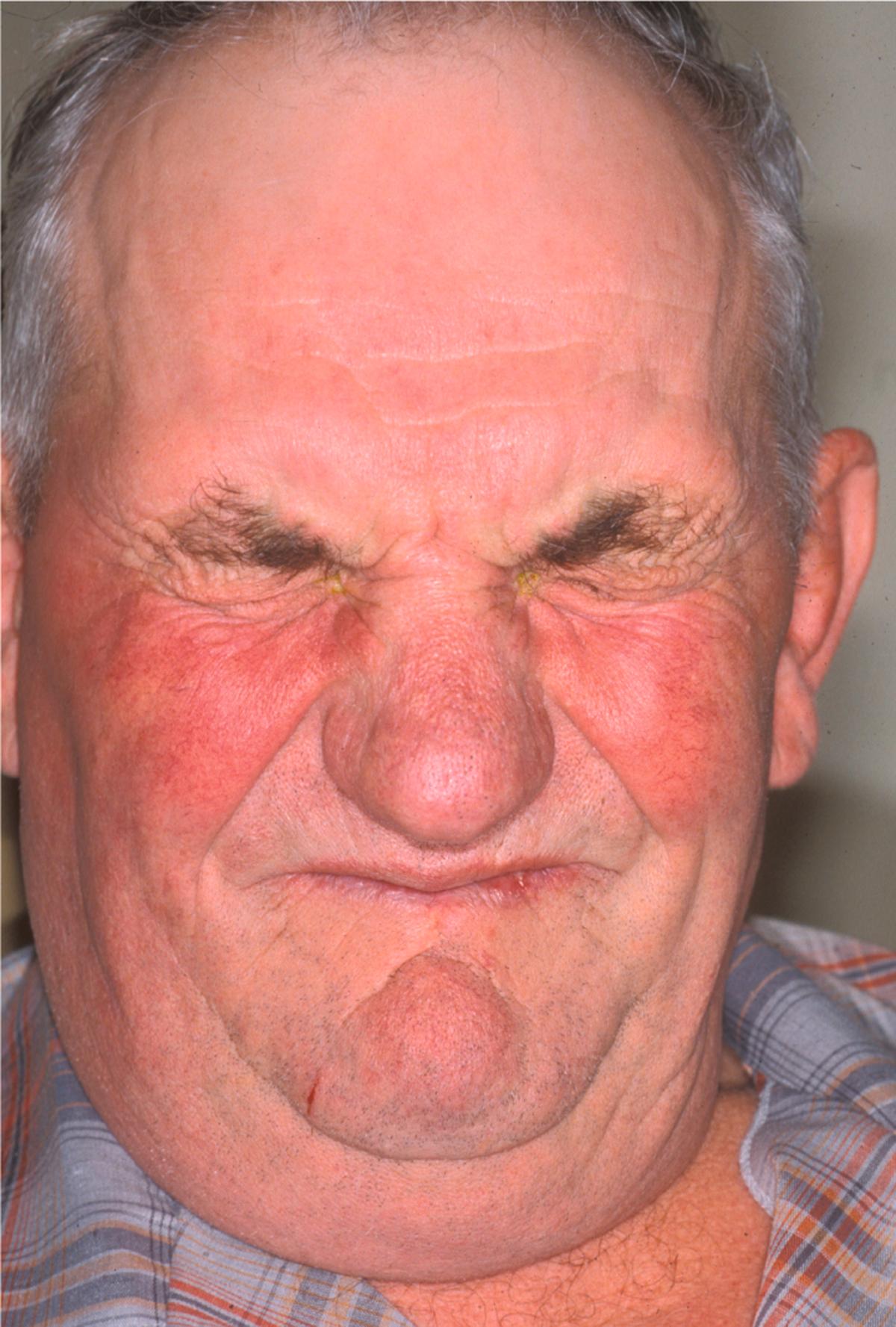
When diagnosing abnormal movements of the face, your history taking and physical examination occur at the same time. You learn to watch the patient as you take the history. As you see the type of spasms occurring, you are able to tailor your questions to make a diagnosis.
Several factors are important in arriving at the correct diagnosis:
Age
Onset
Character of the spasm
Quadrants of the face involved
Orbicularis myokymia and tics tend to occur in younger patients. Essential blepharospasm and hemifacial spasm occur in older adults. Orbicularis myokymia has an abrupt onset and usually lasts less than a week. The onset of facial tics may follow a particular event, and they frequently disappear spontaneously over a variable period of time, especially in children. For other patients, a tic may be present for life. Hemifacial spasm and essential blepharospasm generally do not have a specific onset and tend to progress. As you watch the patient, you are able to get a feel for the character of the movement problem. Is the muscle activity a quick twitch or a sustained spasm? Are you seeing an involuntary muscle activity (myokymia, hemifacial spasm, or blepharospasm), or is the abnormal facial movement the result of a voluntary coordinated movement of a group of muscles (a facial tic)? Most of all, you want to determine which parts of the face are involved. This leads the way to determining the diagnosis ( Box 9.1 ).
Divide the face into four quadrants.
First ask yourself if one or both eyes are involved.
If one eye is involved, ask yourself whether the whole side of the face is involved.
If the eye alone is involved, the problem is probably myokymia.
If one eye and the whole side of the face are involved, the diagnosis is probably hemifacial spasm.
If you have identified spasm in both eyes, the patient has either a form of blepharospasm or a facial tic.
Rule out a cause of reflex spasm.
If the patient with bilateral eyelid spasm is younger than 50 years of age, the spasm is probably a tic.
If the patient is 50–60 years or older, the spasm is probably essential blepharospasm.
If the upper and lower regions of the face are involved, the patient has Meige syndrome.
Facial tics can be unilateral or bilateral.
The movements involve a group of muscles under voluntary, but unconscious, control. In many cases, you can trick the patient into stopping the tic for a minute or so to confirm the diagnosis.
It is helpful to divide the face into four quadrants when evaluating patients with movement abnormalities ( Figure 9.9 ).
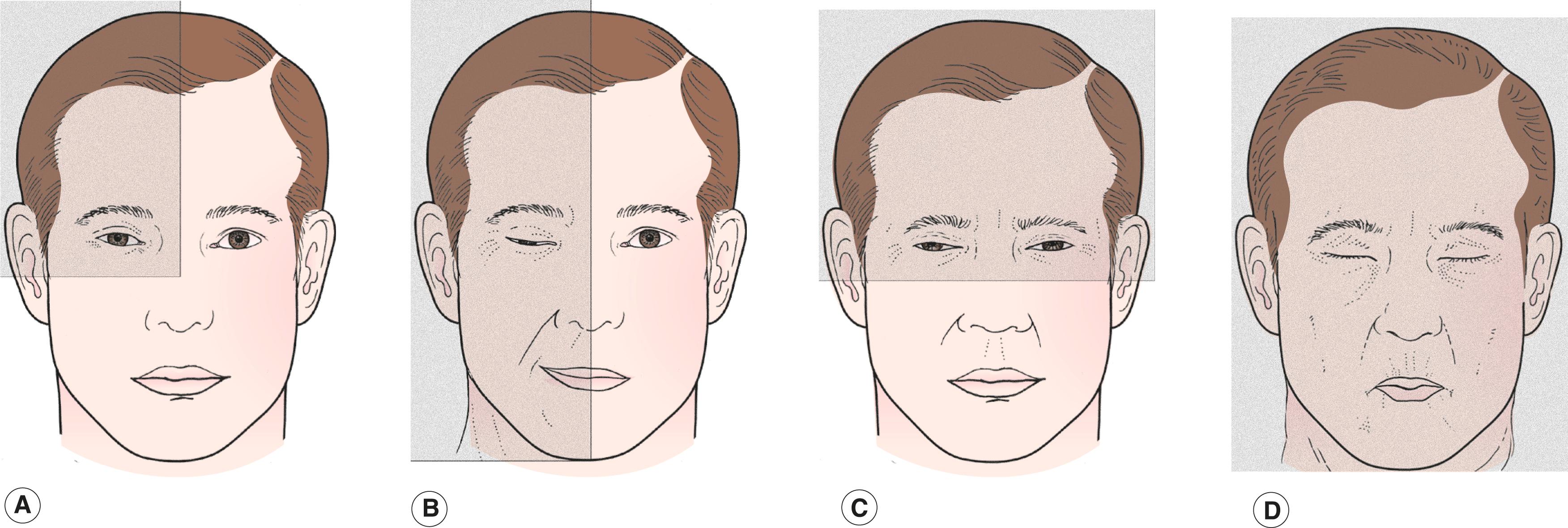
First ask yourself whether one eye or both eyes are involved.
If the answer is one eye, ask yourself whether the whole side of the face is also involved. If the eye alone is involved, the problem is probably myokymia, and you should ask about stress and fatigue. Frequently, the patient tells you that this is a very busy time at school or work. Probably you have had an episode of orbicularis myokymia yourself.
If one eye and the whole side of the face are involved, the diagnosis is probably hemifacial spasm. In general, patients with hemifacial spasm are older than 50 years, but this condition can occur in the 40s. Beware of diagnosing hemifacial spasm in a patient younger than 40 years of age. As you initially examine the patient with hemifacial spasm, there may be no apparent abnormal movements. You may notice that as the patient talks, the spasm starts. This is typical of hemifacial spasm where the so-called cross-talk of nerve fibers initiates the facial spasm. This phenomenon is bothersome to patients because the spasm often starts when they are talking to friends or business acquaintances. If you suspect hemifacial spasm but do not see movements elsewhere in the face, look closely at the chin for dimpling of the mentalis muscle or at the neck for subtle movement of the platysma muscle. You may be able to confirm the diagnosis of hemifacial spasm by asking the patient if the spasm occurs while sleeping. Hemifacial spasm is the only diagnosis where spasms continue in the patient’s sleep.
A tic can involve one side of the face, as well. Patients with a unilateral periocular tic often show bilateral orbital orbicularis activity because it is difficult to lightly blink one eye voluntarily. In most patients, it is easy to identify a tic because the movements seem somewhat bizarre and for some reason you get the idea that the patient is actually causing them. Sometimes I pass by the examination room a few times to see if the movements are occurring in my absence. Frequently, when I enter the room, the facial movements of the tic start. We say the tic is voluntary, but in fact, many patients with tics are not aware that the movements are occurring. The patient is often able to stop the movements for brief periods of time. There are patients, both children and adults, where the movements are intentional, likely providing some secondary gain. If you have identified spasms in both eyes, the patient has either a form of blepharospasm or a facial tic. If the patient with bilateral eyelid spasms is younger than 50 years, the diagnosis is probably a tic. We talk more about tics a few paragraphs from now.
In all patients, you should rule out the possibility of a reflex blepharospasm from some cause of ocular irritation. The reflex spasm is usually obvious in a young patient but may be more difficult to identify in an older patient, who may have an element of dryness in the eye. Ask if the patient has any sensation of a foreign body or burning in the eye. If there is a question of surface irritation causing the spasm, a drop of topical anesthetic should relieve the spasm. If you remain uncertain about the possibility of a reflex component, try lubricants or punctal plugs before proceeding with any other treatment.
Essential blepharospasm occurs as a degenerative disorder seen mainly in patients older than 60 years. It may occur in the 50s, however. Although patients think of the disorder as a spasm disorder, essential blepharospasm is really a loss of the ability to keep the eyes open. Eyelid closure involves simultaneous initiation of the orbicularis muscle activity and suspension of the levator muscle activity. In the early stages of the disorder, increased orbicularis activity, blinking, is the predominant symptom. Over time, the blinking becomes forceful spasms, which can interfere with all activities of daily life. Typically, the symptoms decrease when the patient is busy with an activity such as work or a hobby. Symptoms seem to be worst when the patient is at rest or while the patient is driving or reading. Frequently patients note that they pry their eyelids open to be able to drive. Often, this represents a sensory trick to keep the eyes open. Touching the periocular tissue somehow turns off the spasm through some unknown sensory feedback loop. It is real and is a helpful diagnostic sign (see Figures 9.6 to 9.8 ).
On examination, you see an increased rate of blinking in the early stages of the disease. Usually, the orbital orbicularis muscle is involved. In later stages, the corrugator muscle pulls the eyebrows toward the midline and spasms are sustained. Often, lower facial involvement is noted, with mild abnormal movements of the face, frequently, lip pursing. If present, this lower facial movement helps to confirm the diagnosis of essential blepharospasm. As we said earlier, patients with lower facial involvement and blepharospasm are said to have Meige syndrome.
Sometimes patients tell you that their eyes feel much more comfortable if they are just closed, a symptom that apraxia is developing. Ongoing botulinum injections have improved the spasm, but the patient is left with the inability to open the eyes. As apraxia develops, the patient may think that the botulinum injections are not working because the patient cannot open the eyes. You recognize this in the patient that cannot open the eyes but really has no spasm. When you ask the patient to squeeze the eyelids closed, you see little movement, demonstrating that the injections are, in fact, reducing the orbicularis activity. There is no medical or surgical treatment that can stimulate the levator muscle activity in these patients.
The treatment of facial spasm was revolutionized by the introduction of botulinum toxin (Botox Allergan, botox.com ; Dysport, Galdermadysport.com ; Xeomin, Merz xeomin.com ). The toxin serotype A is produced by Clostridium botulinum and is a potent muscle-paralyzing agent. Injection of botulinum toxin into the orbicularis muscle of the eyelids and eyebrow provides symptomatic relief of spasm for 3 to 4 months (average being 14 weeks), depending on the disease process. Botulinum toxin is the primary treatment for hemifacial spasm and essential blepharospasm. All brands of botulinum toxin can be used to treat these movement disorders ( Table 9.1 ). In this text, the approximate dosing equivalents are given in Botox units. The toxins give similar results. There can be differences in the diffusion properties of the toxins owing to the different molecular weight of each toxin molecule. I suggest that you get familiar with one toxin first. Later you can add the others to your treatment choices. There are some practical considerations regarding cost and wastage that come into play, depending on your particular practice situation.
| Brand Name | Chemical Name | Dose Equivalent |
|---|---|---|
| Botox | Onabotulinumtoxin A | 1 unit |
| Dysport | Abobotulinumtoxin A | 2.5–3 units |
| Xeomin | Incobotulinumtoxin A | 1 unit |
Orbicularis myokymia is a self-limited condition. The spasm usually lasts a few days and rarely more than a week. Botulinum toxin can be used, but be careful that you do not miss a more serious diagnosis if the myokymia persists. Very small amounts of Botox should be used (1 to 2 units per site).
Become a Clinical Tree membership for Full access and enjoy Unlimited articles
If you are a member. Log in here